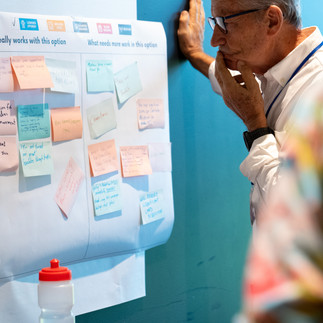Case Study - More than a Road
- Joel Levin
- Aug 28
- 3 min read

Executive Summary
Orrong Road is a major four-lane corridor close to capacity, handling 50,000-65,000 vehicles daily. It links Perth with outer metro areas and is vital for local roads, businesses, and residents. Congestion along Orrong Road/Grahm Framer Freeway costs the WA economy $64.7 million per year in lost productivity and is expected to increase. Previous consultation in 2019, focused on a lowered expressway, showed some support but the survey sample was small and lacked alternative options. A 2023 consultation for a similar road faced strong opposition, prompting Main Roads WA to enhance its engagement approach. In 2024, Aha! Consulting led a robust engagement program alongside Arup Jacobs Joint Venture (AJJV), moving beyond traditional methods and including a community deliberative panel. This approach, new to this context, required rapid assessment of panel options and new ways to assess project feasibility.
Approach
An engagement strategy was implemented from September 2024 to April 2025:
Broad Engagement
Online platforms: project website (5,165 views), interactive page (1,921 visitors), survey (705 responses), social media (reach 30,422), online ideas board and map (35 responses)
In-person: pop-up stalls (170 visitors), letterbox drop (15,308 homes), posters at 10 venues
Regular updates: monthly newsletters (reach 1,780), direct phone contact with 70 businesses
Targeted Stakeholder Engagement
July 2024 to May 2025: regular briefings with key stakeholders and four stakeholder workshops (average 20 participants per workshop) – representatives from local government, state government and industry bodies.
Deliberative Panel
November 2024 to March 2025: 50 randomly, demographically representative panellists
The panel was given this Remit:
“Provide advice and rationale for the future development of the Orrong Road transport corridor that;
o Facilitates optimal movement of local and regional people and businesses
o Delivers desirable social, economic, environmental outcomes
o Contributes to future integrated land use planning
o And is considered financially feasible.
Advice will need to be responsive to relevant State & Local Planning Policies and documents.”
4 full-day sessions, site tour, presentations, 3D printed models, dedicated online portal, continuous support from project team
Panel recommendations achieved 99% consensus
Deliberative panels create robust, defensible recommendations by building a representative sample, enabling deep deliberation with adequate information, and requiring strong consensus for proposals. This method avoids overrepresentation by motivated individuals common in broader engagement.
Challenges
Some challenges faced:
Giving community representatives responsibility for design recommendations
Keeping the panel engaged for five months; managed with online resources and regular contact
Caretaker period communication restrictions; addressed with consistent stakeholder updates
Aligning panel success criteria with complex technical requirements; simplified for clarity
Fast-tracking the design process within three months; required additional resourcing and commitment
Ensuring informed decisions; facilitated with expert presentations and independent facilitation
Participant Feedback
Panel Members
Increased trust in Main Roads WA, with positive sentiment towards their genuine intent (83%pre-panel, 96% post-panel)
Greater understanding of road planning: high/very high increased from 11% to 32% post-panel
All felt facilitation supported decision-making
All agreed group made meaningful recommendations
Appreciation for open, respectful discussions and expert input
Process was seen as data-driven, credible, and genuine
Stakeholders
94% agreed or strongly agreed Main Roads WA was genuine in engagement
94% felt workshops enabled collaborative decision-making
Learnings
Key learnings included:
Early, ongoing engagement builds trust and support
Stakeholder collaboration aligns outcomes and enhances efficiency
Reaching community at local venues and through varied channels captures diverse voices
Transparent and responsive communication is crucial
Caretaker period gaps reduced panel continuity but allowed the design team to refine options
Consistent contact keeps panel engaged during session breaks
Collaborative report writing is effective, but time must be allocated
Trust and transparency between project partners is vital
Conclusion
Main Roads WA's engagement approach for Orrong Connect set a new benchmark in early project planning, delivering deep insights into user and resident priorities. World-class outcomes were supported through advocacy and stakeholder collaboration. The robust process, including a representative deliberative panel, enhanced social licence and support for complex transport
projects. Feedback to date affirms the project's success in genuine engagement and informed decision-making.



















Comments